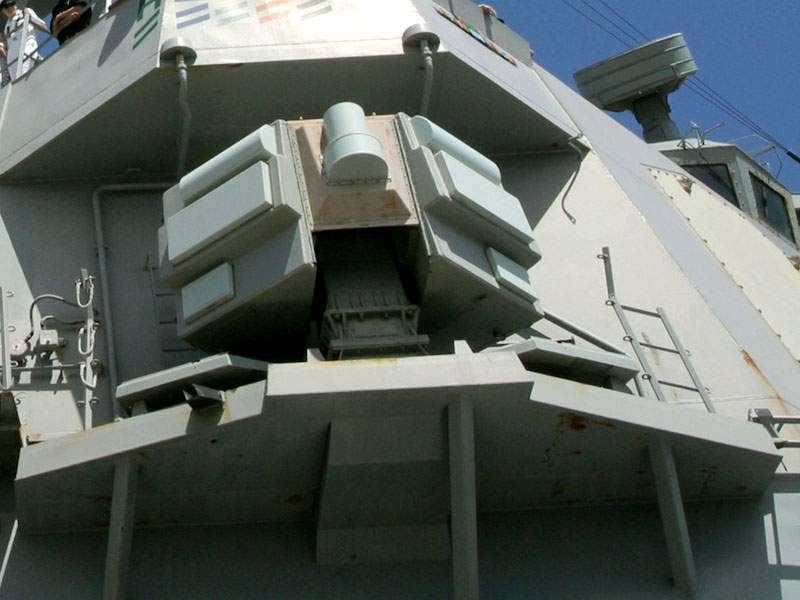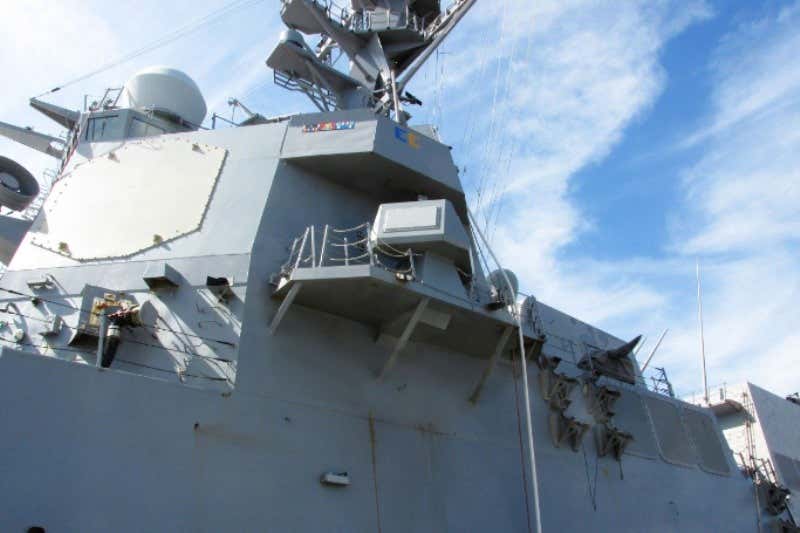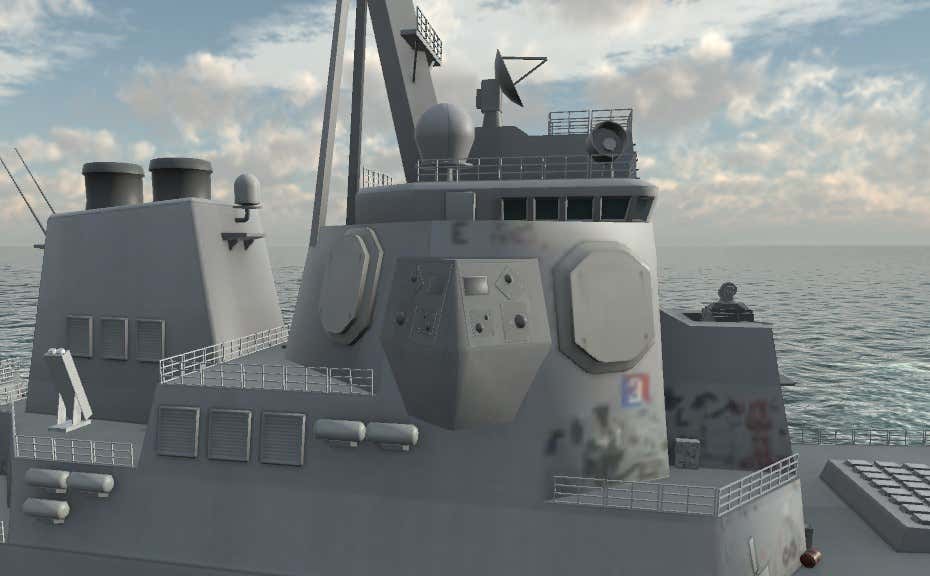SEWIP Block III will introduce new electronic attack capabilities and other enhancements as the Navy prepares to defend its ships in a high-end fight.

They aren't as exciting as high-tech missiles, Gatling guns, or even lasers, but the electronic warfare systems, and their associated decoys, installed aboard U.S. Navy ships are arguably the most important components on board when it comes to defending the ship from missile attacks. Now, the biggest leap in the Navy's shipboard electronic warfare arsenal is about to be deployed for the first time.
Northrop Grumman's latest iteration of the long-running AN/SLQ-32 Surface Electronic Warfare Improvement Program (SEWIP) family of electronic warfare systems, which are designed to defend ships against anti-ship missile attacks, provide enhanced situational awareness across the electromagnetic spectrum, and, in some cases, execute other electronic warfare functions, is about to hit the sea. The new system is dubbed the AN/SLQ-32(V)7 SEWIP Block III.

An earlier variant of the AN/SLQ-32 family aboard an Arleigh Burke class destroyer.
SEWIP Block III follows the relatively recent fielding of SEWIP Block II. While the former greatly enhanced the situational awareness provided by the system and streamlined the hardware and software configurations that underpin it, the latter will provide cutting-edge electronic attack capability, one that is far more dynamic than what exists in earlier SEWIP iterations, including their add-on jammers, like Sidekick. You can read all about SEWIP Block II and Block III in this past piece of ours.

SEWIP Block II
SEWIP Block III and Block II are part of the Navy's Integrated Topside initiative that aims to reduce and streamline the numerous arrays and antennas that are scattered around a surface combatant's deck and superstructure and integrate them into a more seamless architecture.
These latest iterations of SEWIP, which has an operational lineage dating back over four decades, are critical to be able to defeat emerging threats and to leverage what has become a renaissance in electronic warfare across the services. The Navy, in particular, is working on extremely ambitious distributed concepts to dominate the electronic battlespace and confuse and blind the enemy. SEWIP Block III, with its next-generation active jamming technology, is likely to be a major part of this and will allow groups of ships to better work together to defeat threats electronically.
Northrop Grumman's press release that accompanied the photo of the system at the top of this article states:
It isn't exactly clear what the final SEWIP Block III configuration will look like, although the enclosure of arrays and emitters shown in the image at the top of this post gives us at least a partial idea of what will be included with the production system.

This official artist rendering of SEWIP Block III looks very similar to the image of the test unit at the top of this post
SEWIP Block III has been developed alongside a far murkier system that was rushed into service in the Pacific and has since migrated to other vessels across the U.S. Navy's fleet. That system is known as the AN/SLQ-59, which you can read more about in this past feature of ours. It remains unclear what the relationship will be with this system and SEWIP Block III once the latter is fielded.

AN/SLQ-59 aboard an Arleigh Burke class destroyer based in Japan
While defending a ship against anti-ship missile attacks and providing situational awareness as to threats in its vicinity are the bread and butter of SEWIP, the Block III variant is likely to be able to do other things. These could include jamming enemy communications, data-links, drone transmissions, and executing direct electronic attacks on assets such as aircraft and other ships. A communications role in the future may even be possible. The backend software and inherent adaptability of the system will also allow it to be modified with relative ease and take advantage of new electronic surveillance and attack capabilities. These may include leveraging non-organic emitters, like the powerful SPY-6 AESA radar that may be back fitted for older Fight II Arleigh Burke class destroyers and will be standard on newer Flight III ones.
As it sits today, SEWIP Block III is set to debut in its initial configuration next year aboard an Arleigh Burke class destroyer. When it arrives, it will usher in a new era in naval electronic warfare for America's seagoing service's surface combatants.

 www.thedrive.com
www.thedrive.com
They aren't as exciting as high-tech missiles, Gatling guns, or even lasers, but the electronic warfare systems, and their associated decoys, installed aboard U.S. Navy ships are arguably the most important components on board when it comes to defending the ship from missile attacks. Now, the biggest leap in the Navy's shipboard electronic warfare arsenal is about to be deployed for the first time.
Northrop Grumman's latest iteration of the long-running AN/SLQ-32 Surface Electronic Warfare Improvement Program (SEWIP) family of electronic warfare systems, which are designed to defend ships against anti-ship missile attacks, provide enhanced situational awareness across the electromagnetic spectrum, and, in some cases, execute other electronic warfare functions, is about to hit the sea. The new system is dubbed the AN/SLQ-32(V)7 SEWIP Block III.

An earlier variant of the AN/SLQ-32 family aboard an Arleigh Burke class destroyer.
SEWIP Block III follows the relatively recent fielding of SEWIP Block II. While the former greatly enhanced the situational awareness provided by the system and streamlined the hardware and software configurations that underpin it, the latter will provide cutting-edge electronic attack capability, one that is far more dynamic than what exists in earlier SEWIP iterations, including their add-on jammers, like Sidekick. You can read all about SEWIP Block II and Block III in this past piece of ours.

SEWIP Block II
SEWIP Block III and Block II are part of the Navy's Integrated Topside initiative that aims to reduce and streamline the numerous arrays and antennas that are scattered around a surface combatant's deck and superstructure and integrate them into a more seamless architecture.
These latest iterations of SEWIP, which has an operational lineage dating back over four decades, are critical to be able to defeat emerging threats and to leverage what has become a renaissance in electronic warfare across the services. The Navy, in particular, is working on extremely ambitious distributed concepts to dominate the electronic battlespace and confuse and blind the enemy. SEWIP Block III, with its next-generation active jamming technology, is likely to be a major part of this and will allow groups of ships to better work together to defeat threats electronically.
Northrop Grumman's press release that accompanied the photo of the system at the top of this article states:
Northrop Grumman’s approach to this system is centered on a ‘software defined, hardware enabled’ open architecture that quickly integrates with other combat systems while adopting the latest electronic attack capabilities to ensure the system remains ahead of the threat and supports the U.S. Navy’s Distributed Maritime Operations (DMO) CONOPS.
The $100.7 million base contract is for the first follow on production lot of AN/SLQ-32(V)7 Surface Electronic Warfare Improvement Program (SEWIP) Block 3 electronic warfare systems. The contract has a maximum value of $1.16 billion. The system will be installed initially on Arleigh-Burke class destroyers and is scalable to other ship classes.
SEWIP Block 3 is the third in a series of incremental upgrades that adds an electronic attack (EA) capability to the AN/SLQ-32 electronic warfare (EW) system to defend ships against anti-ship missiles. The program is managed by the U.S. Navy Program Executive Office Integrated Warfare Systems (PEO IWS).
“With this follow on production award, Northrop Grumman will continue to provide game-changing maritime EW capability that will underpin future Fleet Electromagnetic Maneuver Warfare operations” said Ingrid Vaughan, vice president and general manager, maritime/land systems and sensors, Northrop Grumman. “We are writing a new chapter in the evolution of the AN/SLQ-32 that will fundamentally change how the Fleet will win the fight for years to come.”
It isn't exactly clear what the final SEWIP Block III configuration will look like, although the enclosure of arrays and emitters shown in the image at the top of this post gives us at least a partial idea of what will be included with the production system.

This official artist rendering of SEWIP Block III looks very similar to the image of the test unit at the top of this post
SEWIP Block III has been developed alongside a far murkier system that was rushed into service in the Pacific and has since migrated to other vessels across the U.S. Navy's fleet. That system is known as the AN/SLQ-59, which you can read more about in this past feature of ours. It remains unclear what the relationship will be with this system and SEWIP Block III once the latter is fielded.

AN/SLQ-59 aboard an Arleigh Burke class destroyer based in Japan
While defending a ship against anti-ship missile attacks and providing situational awareness as to threats in its vicinity are the bread and butter of SEWIP, the Block III variant is likely to be able to do other things. These could include jamming enemy communications, data-links, drone transmissions, and executing direct electronic attacks on assets such as aircraft and other ships. A communications role in the future may even be possible. The backend software and inherent adaptability of the system will also allow it to be modified with relative ease and take advantage of new electronic surveillance and attack capabilities. These may include leveraging non-organic emitters, like the powerful SPY-6 AESA radar that may be back fitted for older Fight II Arleigh Burke class destroyers and will be standard on newer Flight III ones.
As it sits today, SEWIP Block III is set to debut in its initial configuration next year aboard an Arleigh Burke class destroyer. When it arrives, it will usher in a new era in naval electronic warfare for America's seagoing service's surface combatants.

The Navy Is About To Sail With Its Next Big Leap In Shipboard Electronic Warfare Systems
SEWIP Block III will introduce new electronic attack capabilities and other enhancements as the Navy prepares to defend its ships in a high-end fight.


